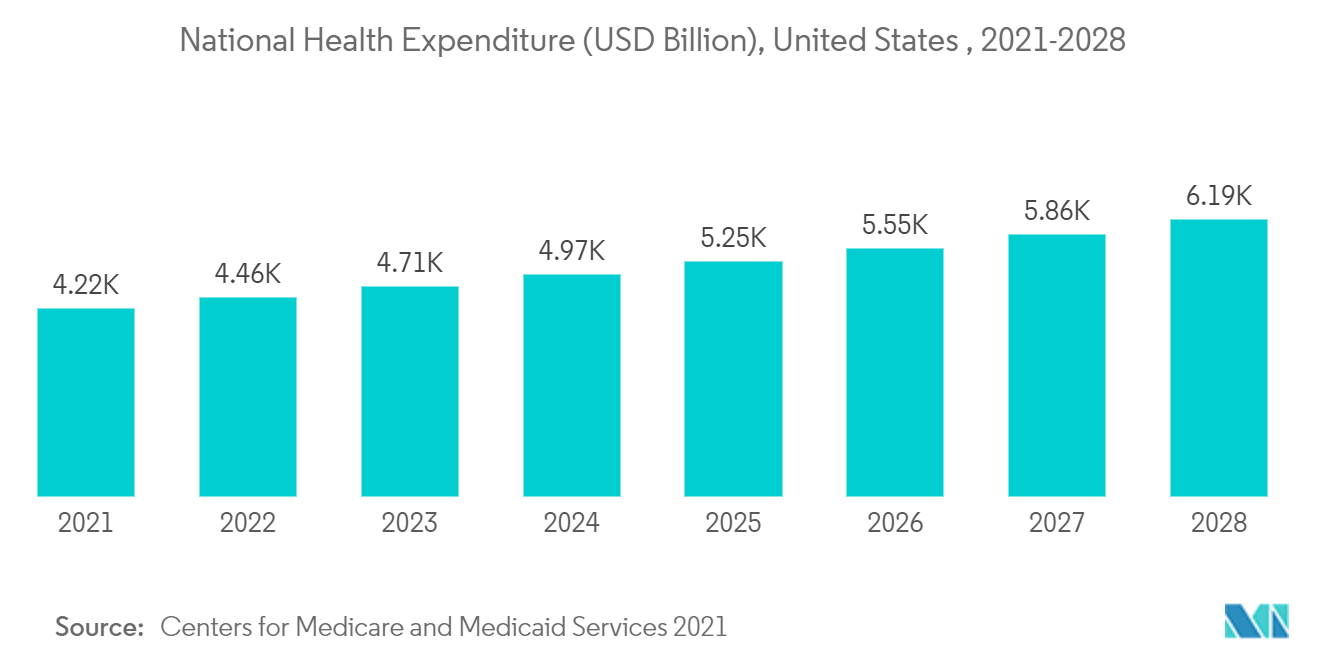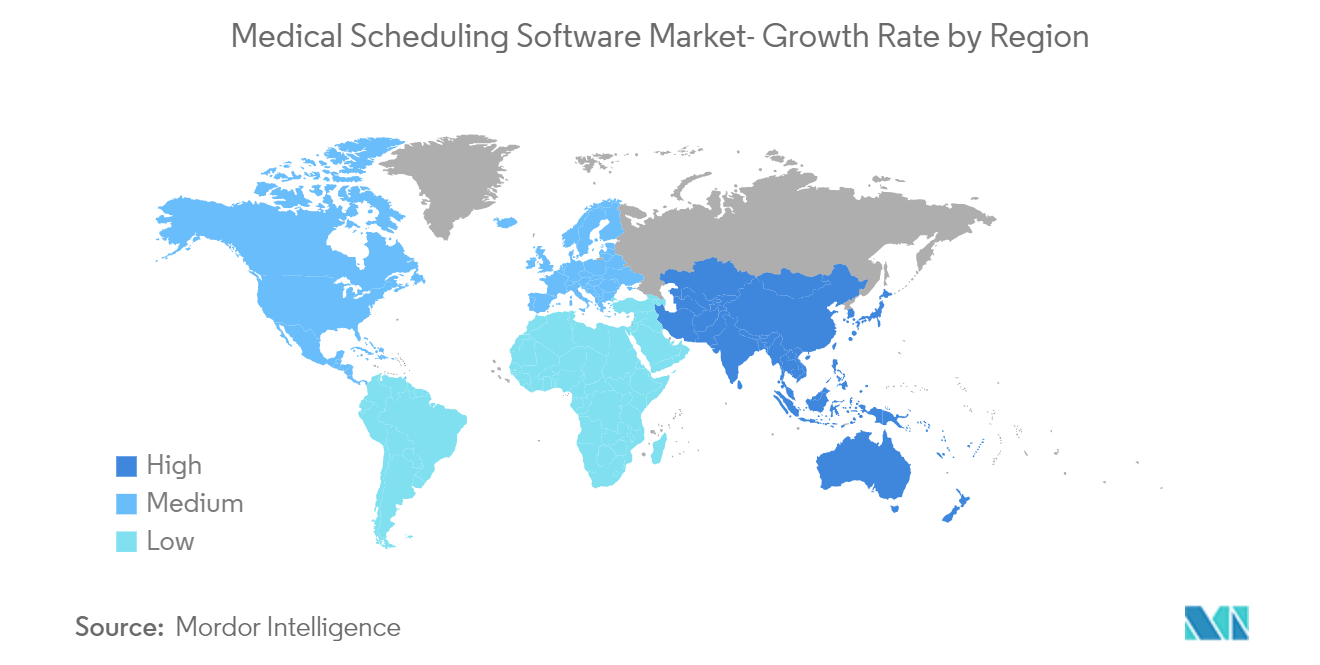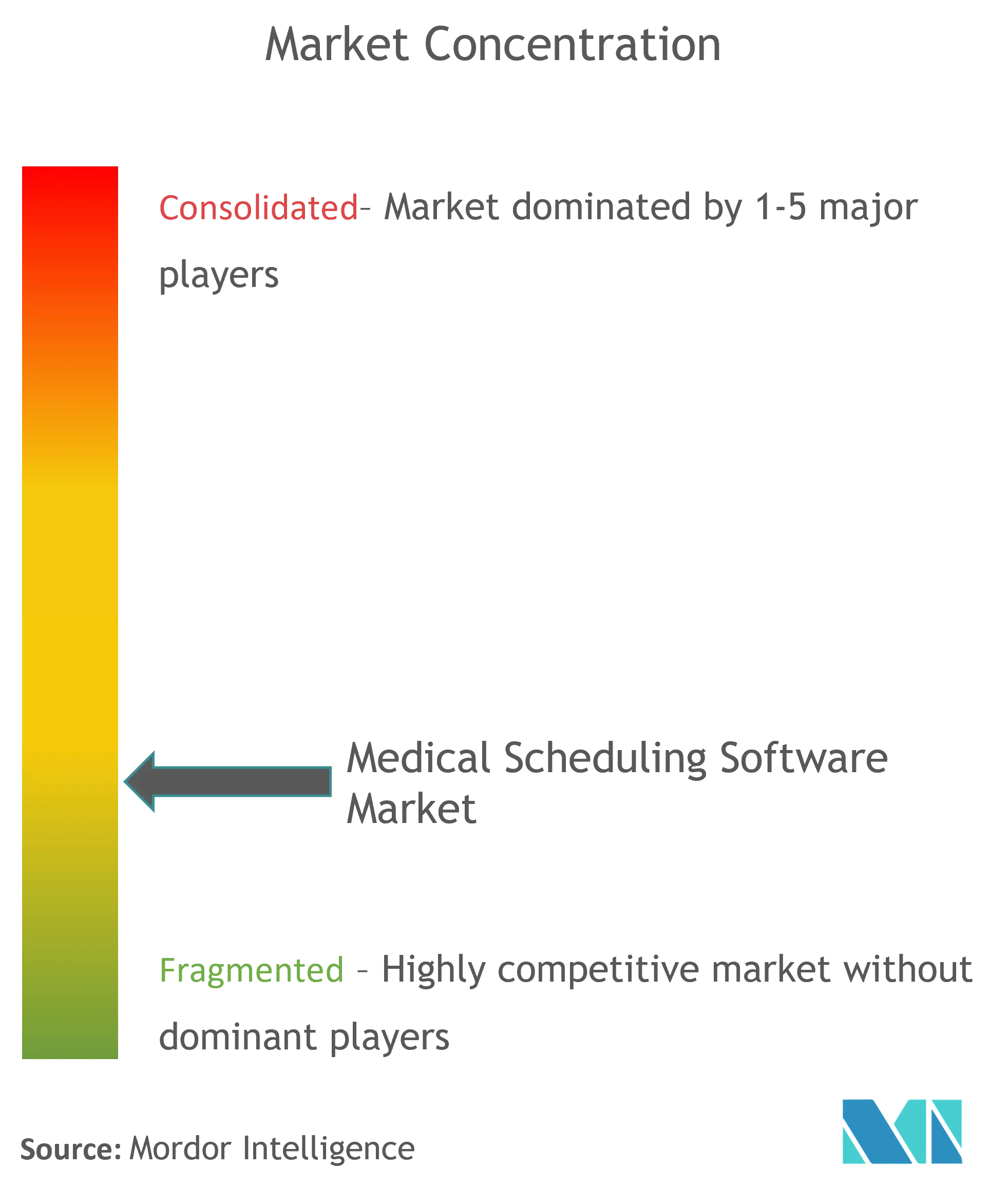Medical Scheduling Software Market Size

| Study Period | 2019 - 2029 |
| Base Year For Estimation | 2023 |
| CAGR | 12.00 % |
| Fastest Growing Market | Asia-Pacific |
| Largest Market | North America |
| Market Concentration | High |
Major Players
*Disclaimer: Major Players sorted in no particular order |
Medical Scheduling Software Market Analysis
The medical scheduling software market is expected to register a CAGR of 12% during the forecast period, 2022-2027.
During the early phase of the pandemic, medical visits declined, obstructing the use and demand for medical scheduling software, thereby impacting the market growth. For instance, as per a September 2020 update by the Centers for Disease Control and Prevention (CDC), due to concerns about COVID-19, an estimated 41% of United States adults had delayed or avoided medical care, including urgent or emergency care (12%) and routine care (32%). Thus, the pandemic initially had a short-term negative impact on the market. However, with the pandemic still in its expansion phase, several companies started launching software for scheduling patient visits to accelerate the number of vaccinations and for routine patient care to assist patients during the COVID-19 pandemic. For instance, in January 2021, ServiceNow launched COVID-19 vaccine management tools designed to make it easier to scale distribution, administration, and monitoring, including scheduling for vaccine administrators and supplies under vaccine administration management. The company's vaccine administration management offering is built on ServiceNow's Customer Service Management platform. Thus, such factors are anticipated to boost the market's growth over the coming years.
Furthermore, the market's growth can be attributed to rising demand for efficiently managed and optimized workflows, a surge in product launches and developments, and the increasing adoption of a patient-centric approach.
Patient scheduling is a complicated procedure that plays a vital role in health care, which can be simplified using medical scheduling software, encouraging patient and physician satisfaction. Patient appointment scheduling SaaS software enables practices to simplify administrative tasks such as appointment scheduling, invoicing, and managing patient records. Thus, medical scheduling software aids in optimizing workflow and managing patient visits, and several market players are engaged in introducing new medical scheduling software. For instance, in April 2022, the patient experience platform NexHealth banked USD 125 million in a Series C funding round, sending its valuation to USD 1 billion. The startup aims to provide a seamless digital experience for patients, simplifying tasks like scheduling and messaging while automating back-end administrative processes for doctors and dentists. Additionally, in July 2021, Power Diary, a telehealth company based in Salt Lake City, Utah, launched a proprietary practice management software for medical clinics across the United States.
However, the risk of data security and the shortage of skilled professionals are the major factors restraining the market's growth.
Medical Scheduling Software Market Trends
This section covers the major market trends shaping the Medical Scheduling Software Market according to our research experts:
Cloud-based Segment is Expected to Register a Significant Growth Over the Forecast Period
The cloud-based software segment is expected to witness significant growth by deployment type. Cloud-based is the applications, services, or resources made available to users on demand through the internet by a cloud computing provider's server.
The major factors fuelling the segment's growth are the rising adoption of cloud computing and the growing number of initiatives undertaken by the market players. For instance, in November 2021, PerfectServe, a leading cloud-based clinical collaboration and provider scheduling solution, introduced PerfectServe Unite. The new platform builds on the company's extensive experience designing award-winning technology to form one seamless, end-to-end platform for healthcare scheduling and communication.
In addition, in November 2021, QGenda, the leading innovator in healthcare workforce management solutions, acquired Schedule360, the Best in KLAS Nurse and Staff Scheduling Software for health systems, academic medical centers, national pharmacy chains, and providers of cloud-based software to automate nurse and staff scheduling.
Moreover, in May 2020, Microsoft launched a new cloud service designed specifically for healthcare, the first of many industry-specific cloud offerings. The cloud service focuses on what Microsoft has identified as important needs in healthcare, such as patient engagement, health team collaboration, and improving operational efficiencies. The cloud service will enable providers to schedule telehealth visits with Microsoft Teams through the booking application.
Thus, the segment is expected to witness significant growth over the forecast period due to the abovementioned factors.

North America is Expected to Hold a Significant Share in the Market and Expected to do Same in the Forecast Period
North America is expected to hold a major share of the market. The major factors propelling the market growth in the region are the well-established healthcare infrastructure, technological advancements in the healthcare IT industry in the country, and increasing initiatives by the market players.
The strategic developments undertaken by the market players significantly contribute to the market's growth. For instance, in August 2021, symplr reported the acquisition of SpinFusion. SpinFusion, a healthcare scheduling software provider focusing on physician scheduling, will join Symplr's growing portfolio of workforce management offerings that enable healthcare organizations to optimize staff better.
In addition, in June 2020, Claendly LLC introduced an Intercom application, supplementing the existing Messenger application to streamline workflows and permit employees to focus on scheduling appointments with more qualified leads and speeding up sales cycles. Moreover, in January 2020, R1 RCM Inc., an American revenue cycle management company servicing hospitals, health systems, and physician groups across the United States, reported spending USD 190 million to buy SCI Solutions Inc., a Seattle-based provider of scheduling and patient-access software.
Furthermore, according to a December 2021 update from the Centers for Medicare & Medicaid Services, healthcare spending in the United States increased 9.7 percent in 2020, reaching USD 4.1 trillion, or USD 12,530 per person. As per the same source, as a share of the nation's gross domestic product, health spending accounted for 19.7 percent. Also, in August 2020, the Ontario government reported investing USD 149,200 from the Ontario Together Fund in MetricAid's physician scheduling solution to help physicians link their availability and expertise with needed hospitals and clinics while reducing administrative burden so healthcare providers can focus on their patients.
Thus, due to the abovementioned factors, the market is expected to witness significant growth over the forecast period.

Medical Scheduling Software Industry Overview
The medical scheduling software market is competitive with several global and international market players. The key players are adopting different growth strategies to enhance their market presence, such as partnerships, agreements, collaborations, new product launches, geographical expansions, mergers, and acquisitions. Some of the key players in the market are American Medical Software, Kryuus, Caspio, AdvancedMD, Inc., and Q-nomy Inc.
Medical Scheduling Software Market Leaders
-
American Medical Software
-
Kyruus
-
Caspio
-
AdvancedMD, Inc.
-
Q-nomy Inc.
*Disclaimer: Major Players sorted in no particular order

Medical Scheduling Software Market News
- In August 2022 Kyruus partnered with Christus health partners to create a modern digital directory to showcase the distinguished physicians and advanced practitioners in the health care network and enhance its online find care experience with richer information that fosters better patient-provider matching.
- In April 2022 Kyruus partnered with Upfront to help healthcare organizations with patient acquisition, activation, and retention. This combination of both platforms allows healthcare organizations to create better digital experiences for their patients.
Medical Scheduling Software Market Report - Table of Contents
1. INTRODUCTION
- 1.1 Study Assumptions and Market Definition
- 1.2 Scope of the Study
2. RESEARCH METHODOLOGY
3. EXECUTIVE SUMMARY
4. MARKET DYNAMICS
- 4.1 Market Overview
-
4.2 Market Drivers
- 4.2.1 Increasing Demand of Software to Efficiently Manage and Optimize Workflow
- 4.2.2 Rising Adoption of Patient-Centric Approach
-
4.3 Market Restraints
- 4.3.1 Risk of Data Security and Dearth of Skilled Professionals
-
4.4 Porter's Five Forces Analysis
- 4.4.1 Threat of New Entrants
- 4.4.2 Bargaining Power of Buyers/Consumers
- 4.4.3 Bargaining Power of Suppliers
- 4.4.4 Threat of Substitute Products
- 4.4.5 Intensity of Competitive Rivalry
5. MARKET SEGMENTATION (Market Size by Value - USD million)
-
5.1 By Product Type
- 5.1.1 Patient Scheduling
- 5.1.2 Care Provider Scheduling
- 5.1.3 Others
-
5.2 By Deployment type
- 5.2.1 Cloud-Based
- 5.2.2 Installed
-
5.3 By End User
- 5.3.1 Hospitals
- 5.3.2 Clinics
- 5.3.3 Others
-
5.4 Geography
- 5.4.1 North America
- 5.4.2 Europe
- 5.4.3 Asia-Pacific
- 5.4.4 Middle-East and Africa
- 5.4.5 South America
6. COMPETITIVE LANDSCAPE
-
6.1 Company Profiles
- 6.1.1 PatientStudio
- 6.1.2 Yocale Network Corporation
- 6.1.3 Tinivia
- 6.1.4 10to8 Ltd.
- 6.1.5 American Medical Software
- 6.1.6 Kyruus
- 6.1.7 Caspio
- 6.1.8 AdvancedMD, Inc.
- 6.1.9 Q-nomy Inc.
- 6.1.10 Terminapp GmbH
- 6.1.11 SuperSaaS
- 6.1.12 Biosoftworld Medical Software
- 6.1.13 Vocantas Inc.
- *List Not Exhaustive
7. MARKET OPPORTUNITIES AND FUTURE TRENDS
** Subject To AvailablityMedical Scheduling Software Industry Segmentation
As per the scope of the report, the medical scheduling software aids the medical practitioners in managing and automating patient scheduling and care provider practices. The market is segmented by segmented Product Type (Patient Scheduling, Care Provider Scheduling, and Others), Deployment Type (Cloud-based and Installed), End User (Hospitals, Clinics, and Other End Users), and Geography (North America, Europe, Asia-Pacific, Middle-East and Africa, and South America). The report offers the value (USD million) for the above segments.
| By Product Type | Patient Scheduling |
| Care Provider Scheduling | |
| Others | |
| By Deployment type | Cloud-Based |
| Installed | |
| By End User | Hospitals |
| Clinics | |
| Others | |
| Geography | North America |
| Europe | |
| Asia-Pacific | |
| Middle-East and Africa | |
| South America |
Medical Scheduling Software Market Research FAQs
What is the current Global Medical Scheduling Software Market size?
The Global Medical Scheduling Software Market is projected to register a CAGR of 12% during the forecast period (2024-2029)
Who are the key players in Global Medical Scheduling Software Market?
American Medical Software, Kyruus, Caspio, AdvancedMD, Inc. and Q-nomy Inc. are the major companies operating in the Global Medical Scheduling Software Market.
Which is the fastest growing region in Global Medical Scheduling Software Market?
Asia-Pacific is estimated to grow at the highest CAGR over the forecast period (2024-2029).
Which region has the biggest share in Global Medical Scheduling Software Market?
In 2024, the North America accounts for the largest market share in Global Medical Scheduling Software Market.
What years does this Global Medical Scheduling Software Market cover?
The report covers the Global Medical Scheduling Software Market historical market size for years: 2019, 2020, 2021, 2022 and 2023. The report also forecasts the Global Medical Scheduling Software Market size for years: 2024, 2025, 2026, 2027, 2028 and 2029.
Global Medical Scheduling Software Industry Report
Statistics for the 2024 Global Medical Scheduling Software market share, size and revenue growth rate, created by Mordor Intelligence™ Industry Reports. Global Medical Scheduling Software analysis includes a market forecast outlook to 2029 and historical overview. Get a sample of this industry analysis as a free report PDF download.



